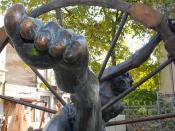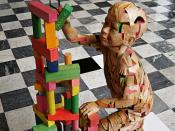Sculpture is one of the few pieces of art that engages our senses differently than with any other type of art. This is because sculpture occupies spaces a three-dimensional mass, compared to paintings that occupy two-dimensional spaces. Paintings and other two- dimensional artwork can suggest density, but sculpture is dense. We fully apprehend sculpture by using no only the visual and tactile senses, but also the weight and volume behind those surfaces.
However, Sculpture is not experienced only by sight alone. Our nervous system is much more complex. When something triggers a sense, a chain reaction of all the other sensors follows, by either sensory motor connections or memory association. We are constantly grasping and handling things, as well as seeing, smelling, tasting, and hearing them. When we see an object, we can generalize how the object feels, how it sounds when hit, how it tastes, and how it smells if we were to approach it.
All of the senses are involved in sculpture, but touch is much more involved in our participation with sculpture. By clarifying such differences, we get a better understanding of the sculpture and therefore, a more rewarding participation.
There are many ways to evaluate art. When we evaluate sculpture, we become a critic. As a responsible critic, we aim for the fullest understanding and participation with a sculpture. By understanding all of the concepts of art and the necessity for participation when evaluating it, we get a better understanding of those concepts, thus allowing us a more refined second experience and wiser critic of the arts.
There are three different types of criticism: descriptive - focusing on form, interpretive - focusing on content, and evaluative - focusing on the relative merits of a work. Each type sharpens our perceptions of a form of art and...


